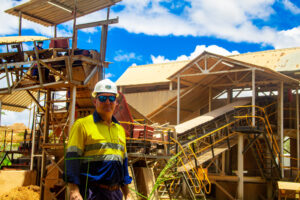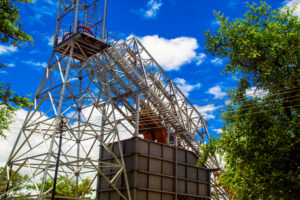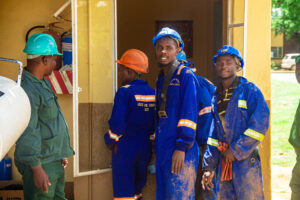Mopani Gold, a high-grade gold producer owned by Maris Africa, is set to significantly increase its production at the Venice Mine Complex (VMC) in Kadoma, Mashonaland West, Zimbabwe. The company plans to triple underground ore production, upgrade processing facilities, and develop a world-class Corporate Social Responsibility (CSR) strategy.
 Speaking to Mining Zimbabwe on a mine visit at Venice Complex Mine in January 2024, Mopani Gold Chief Executive Officer Marc Nicolle said Venice Mine is transitioning between two main sources of ore. The company is nearing the end of re-processing the six historic tailings dumps on site, which together hold 2.1 million tons of material. Secondly, it is undertaking underground mining operations in several of the complex’s mines following significant investment over several years.
Speaking to Mining Zimbabwe on a mine visit at Venice Complex Mine in January 2024, Mopani Gold Chief Executive Officer Marc Nicolle said Venice Mine is transitioning between two main sources of ore. The company is nearing the end of re-processing the six historic tailings dumps on site, which together hold 2.1 million tons of material. Secondly, it is undertaking underground mining operations in several of the complex’s mines following significant investment over several years.
Power generation
 As part of its efforts to have a sustainable power supply, VMC engaged Equator Energy to set up a solar plant for its electricity usage. The almost 1MW plant currently powers more than half of the mine’s consumption at its peak electricity production.
As part of its efforts to have a sustainable power supply, VMC engaged Equator Energy to set up a solar plant for its electricity usage. The almost 1MW plant currently powers more than half of the mine’s consumption at its peak electricity production.
According to Nicolle, the VMC solar plant was recently expanded from 7 inverters to 11 inverters and a group of women are employed from the local community at the plant to keep the solar panels clean and therefore produce power optimally. Nicolle said mining companies are well placed to benefit from a strategy whereby they allow power companies to invest and set up electricity at their premises after which they can buy the power from them. Equator Energy is a particularly good option in that the company will fund the full investment and sell power to the mine on an attractive take-and-pay basis at very competitive prices.
“In 2017 first part of the solar plant was installed. Recently there was a plant expansion from 7 inverters to 11 inverters and the installed plant is now nearly 1MW in size. The solar plant can power the Abbey hoist, elution circuit and the crushing circuit. Solar is offered by a company Equator Energy, and the power is very cost-effectively sold when we need it at USc 8 KWh. In time we will consider plans to expand the solar plant, particularly after the underground ore ramp-up.” Nicolle said.
Ramping up production
 Mopani is in the process of developing the mine, looking to expand from the current underground production to more than triple that level. Although the mine has not allocated money to undertake exploration, there are intentions by Mopani to develop the Venice Mine Complex resource which currently has a life of mine of about 20 years.
Mopani is in the process of developing the mine, looking to expand from the current underground production to more than triple that level. Although the mine has not allocated money to undertake exploration, there are intentions by Mopani to develop the Venice Mine Complex resource which currently has a life of mine of about 20 years.
“We invested nearly a million USD last year in the Abbey hoist which is now operational and is capable of hoisting the targeted 15, 000 tons per month from underground on its own. We are beginning to scale up production as quickly as possible. The Abbey hoist investment will be a cornerstone of our production.
“We want to also invest in exploration in time, at present we have completed a conceptual life of mine plan based on shallow historically mined areas. The grades in that exercise were good and are likely to be even higher as we go deeper into the unmined portions of the property at depth.” Nicolle said.
Venice Mine Underground Manager Perembe Chitambiri revealed that the mine’s underground operations have a set target to triple production from the current 4,000 tonnes per month to 15,000 tonnes per month. The current grades at the mine range from 3 to 6 grams per tonne, with an average of approximately 4 grams per tonne.
“We are currently producing 4000 tonnes a month, we want to go to about 15 000 tonnes a month,” Chitambiri said.
Processing upgrade
As already mentioned, Venice Mine is currently operating on its old tailings and underground operations. Tailings are slurried and fed to the plant using high-pressure process water. Drains then collect the tailings slurry, which is run through a trommel screen to remove larger undesirable material. The slurry passing through the screen is then transported to the carbon-in-leach (CIL) system through a series of pipes.
The recovered tailings slurry is directed into the carbon in leach (CIL) tanks. Cyanide, activated carbon and hydrogen peroxide are added to the CIL circuit for the process to work. Slurry flows by gravity through the CIL leach tanks to ensure the maximum dissolution of gold as a cyanide complex and subsequent adsorption onto activated carbon.
Loaded carbon is transferred to the elution circuit where gold is extracted from the loaded carbon and electroplated before smelting and final refinement.
Corporate Social Responsibility (CSR), strategy
 As part of its CSR, the company is currently engaging communities around its operations to create a more robust and holistic CSR strategy.
As part of its CSR, the company is currently engaging communities around its operations to create a more robust and holistic CSR strategy.
According to its underground Manager Chitambiri, the mine refurbished and is currently renovating the Tafara Venice Primary School block and homes of the community that were damaged by the rains.
He said the mine also provides clean running water for 1400 pupils and teachers at the primary school.
“We have higher aspirations that will come to fruition as the mine expands and generates gold more profitably, our relationship with the community is sound at this stage. We have renovated houses that were affected by rain, about 68 houses. We have approached the community and we are in the process of formulating a more holistic and sustainable strategy with the help of the community.”
According to a senior Teacher at Tafara Venice Primary School, Mr Knowledge Kavhiya VMC has been working to ensure the school is up and running even in difficult situations.
“The mine is in the process of renovating a block that was affected by the rains. Roofs were damaged and all of the roofing sheets have now been replaced. As you can see the builders are almost done. They are currently in the process of renovating the toilets again and we are happy with the support the mine continues to provide. They also supply us with treated running water and our children are well hydrated and we are grateful,” Kavhiya said.
Environmental and Skills sustainability
VMC has a comprehensive environmental management system to monitor the effects of its operations on the environment and address any issues. VMC complies with local and international regulations, including IFC Performance Standards on measuring, mitigating and reporting environmental impact, as well as IFC Environmental, Health and Safety Guidelines for Mining.
In terms of skills sustainability, the company is currently recruiting graduate trainees from the Zimbabwe School of Mines and the Midlands State University to ensure the future of mining in the country is safe.
“We are recruiting students from Zimbabwe School of Mines even from Midlands State University. So several people are coming in as GTs (Graduate Trainees),” Chitambiri said.
Locals Employment
 According to Nicolle through its rampup exercise, the VMC will more than double its employment from the current 400 to around 1200 to 1300 workers.
According to Nicolle through its rampup exercise, the VMC will more than double its employment from the current 400 to around 1200 to 1300 workers.
He said nearly 400 employees are from the local community with only some professional staff unavailable locally from other districts.
“Currently we have about 400 local people working for us and with the ramp-up of production, we can increase that to 1200. We can more than double the jobs here,” Nicolle said.
.png)




